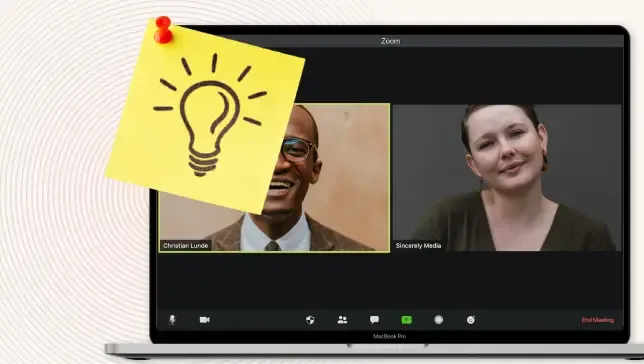How and Why We're Making Video Editing as Easy as Editing Text
June 2021
·
8 min read
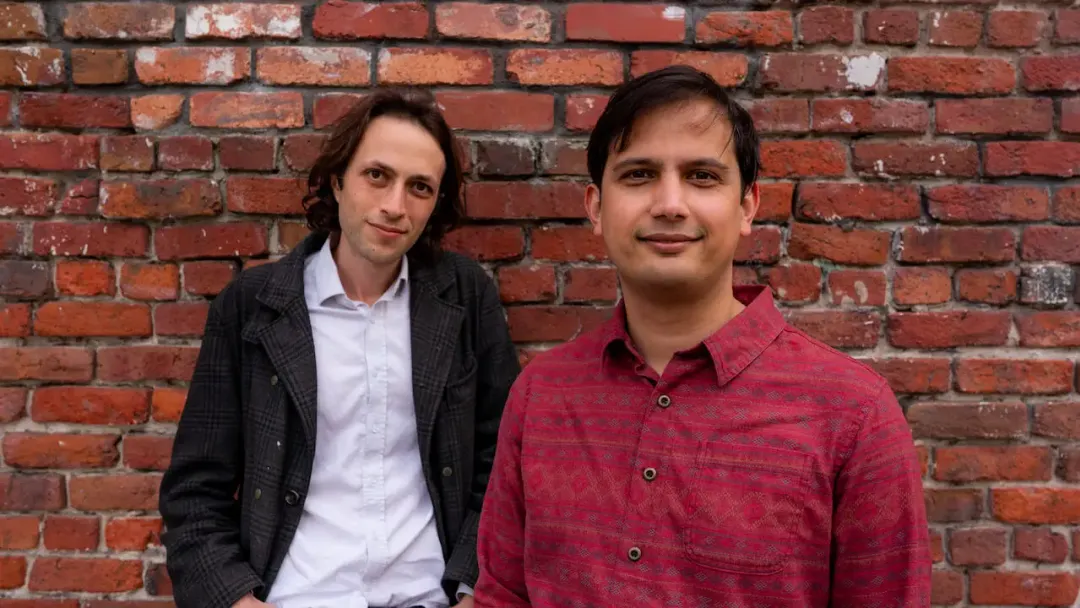
Whether you are a qualitative researcher, marketer, or filmmaker, you have hours and hours of video recordings to work with, but just a few minutes of your audience’s attention to deliver a compelling message. There is gold in your video recordings: great stories and incredible moments that will bring your message to life. But going through hours of recordings, finding those great moments, and editing together a compelling video narrative is extremely time-consuming and painful.
So painful, in fact, that many user researchers and marketers avoid video editing entirely, despite knowing how powerful video can be to represent authentic human voices. For filmmakers, the process of going from raw footage to the rough cut of the story arc is also incredibly tedious and time-consuming, full of awkward workarounds like paper edits created from time-stamped transcripts.
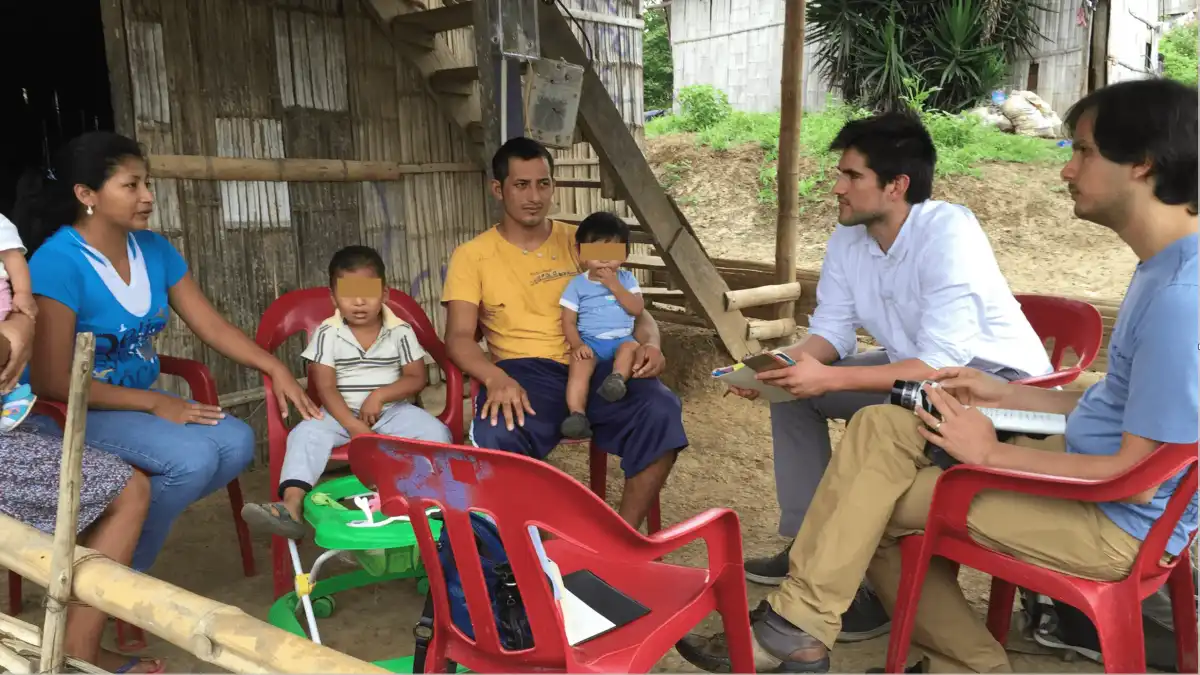
I experienced this first-hand doing design research at the Stanford Design Program. I’d record hours of in-depth user interviews full of incredible insights and stories. When it came to communicating these ideas to a wider audience, it was always a challenge to relay the depth of insight in a short amount of time.
While I could always convey the essentials through reports and presentations, it wasn’t enough. So much gets conveyed outside of words.
If you really want to share what people are thinking, what they feel passionate about, or what really frustrates them — if you want to convey the emotion of that, you need to share the actual video, with people’s actual voices, faces, and intonation intact. But you can’t share hours of recordings with stakeholders, so you need to reduce the video to concise narratives.
But creating these concise video narratives is extremely slow. Just finding the in and out points corresponding to an exact quote you want to pull takes time. You pick a position, cut, play it back. Adjust the position, play it back again. And then do this whole process again for every quote you pull. It takes forever.
Now contrast that with the experience of pulling text quotes. Highlight, copy, paste, done. Notice a stray word or phrase? Select, backspace. It’s practically second nature to any computer user.
Reduct.Video was born when we asked: What if editing video was as easy as editing text?
Fast forward to today and Reduct.Video, our product, does exactly that. It lets anyone who works with video of spoken content find, edit, and share stories with video as easily as text.
In this story, I’ll talk about the origins of Reduct.Video and how our tool makes video editing easy for everybody.
Want to try your hand at editing video content in Reduct.Video? To get started Get a Free Trial and see how easy it is to create powerful video narratives on our platform.
The Time Consuming Challenge of Editing Videos
Like I said, typical video editing involves finding the timing of when certain words are said and cutting exactly at those times. But it’s not as easy as it sounds because the exact moment where words start and stop can be hard to get right the first time. It usually takes a few tries to pinpoint the exact in and out points.
Then, to tell a story with video, you need to string together these clips you’ve pulled, put them together in a timeline, and make sure the story flows from one segment to another. And then you iterate. You re-play the cut, get feedback, and then make adjustments. And every time you do, you repeat this exacting process of finding precise in/out points, cutting, and rearranging.
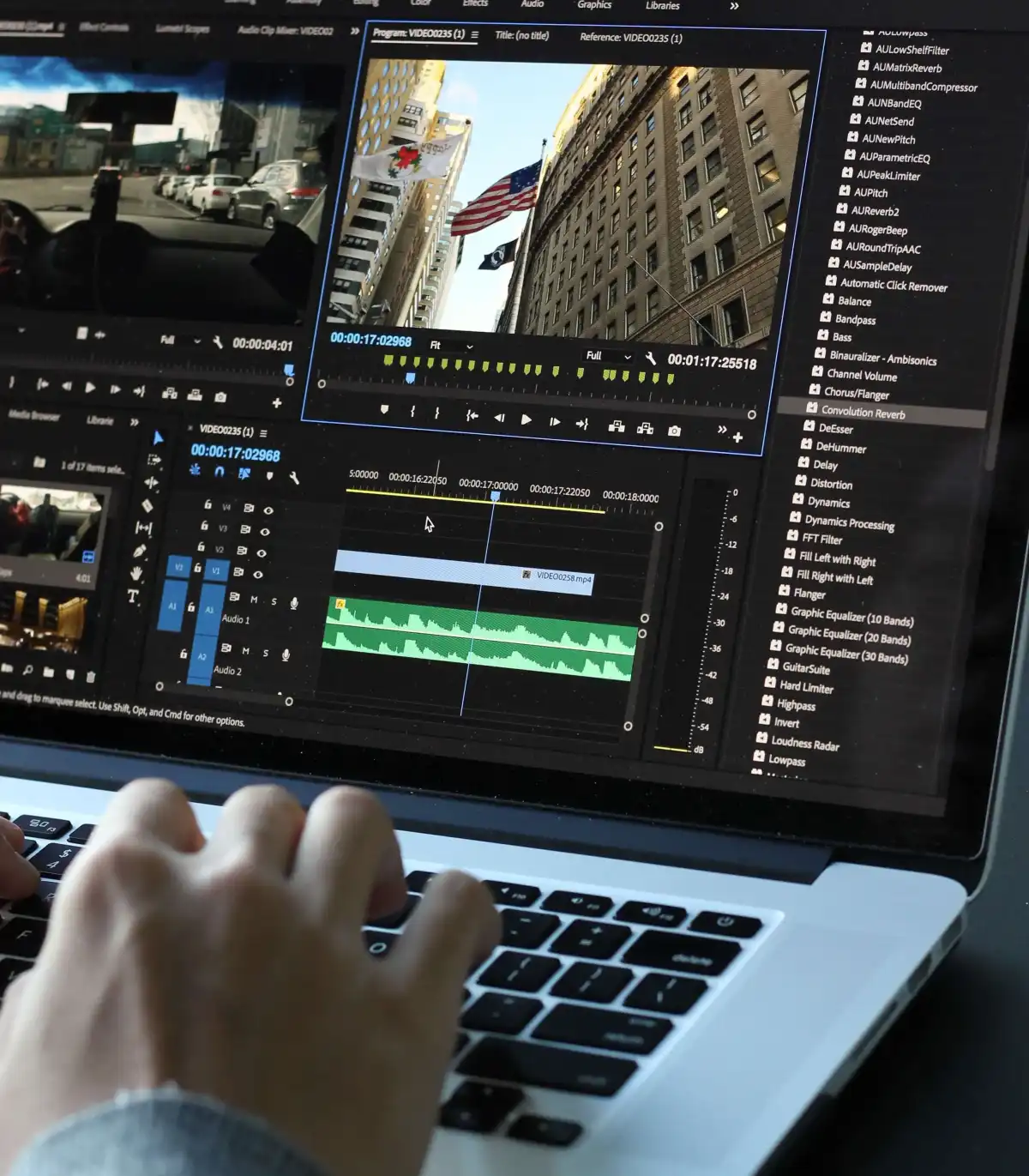
Only adding to the difficulty is the fact that video editing tools are either overly simplistic (iMovie), or really complex and hard to use for the non-professional editor (Adobe Premiere Pro, Apple Final Cut Pro X, Davinci Resolve)
As a result, we’ve found that most non-video professionals that generate a lot of video in their work, like user researchers and marketers, end up not using video very often because it’s too time consuming.
Instead, they just create text based summaries of their work — documents, PowerPoint presentations, and the like. But this means that the nuances and emotions get lost, and the urgency that video can create is simply unutilized.
Stakeholders are left with a shallow understanding — or worse, no buy-in — around the messages you are sharing.
How We Are Able to Edit Video Like It’s Text
In contrast, selecting and editing text is far easier.
If you were tasked with pulling the best 5 quotes from 10 pages of transcripts, it would be extremely easy to execute: you quickly read the transcripts, highlight your top candidates, copy and paste your top five into a new doc — and you’re done!
All of the hard work is in understanding the material and choosing the best quotes. The content. The execution is so simple that it barely deserves comment.
What would it take to work with video interviews in this way?
To start with, you need two parts:
- An accurate transcription of the video.
- Extremely precise timing information, so each word of the transcript is associated with an exact time in the video.
The first step, transcription, is well understood, and as old as writing itself (early writing was largely transcribed speech).
Today, there are marketplaces to get accurate transcripts (99%+) created by trained professionals, and computer-generated transcripts (94% accurate) are commonplace as well. But what made Reduct possible is the second part.
When I was miserably piecing together research highlight reels by hand at Stanford, it so happened that my good friend and now co-founder, Rob Ochshorn, had created an algorithm called Gentle that does this exact thing: it precisely matches the timing of each word in a media file and a corresponding transcript, down to the millisecond.
It’s also quite robust, and can work with media of varying quality, as well as transcriptions created by people or computers.
So with those two things, we had the essential backbone of what is now Reduct.
How Editing in Reduct.Video Works Today
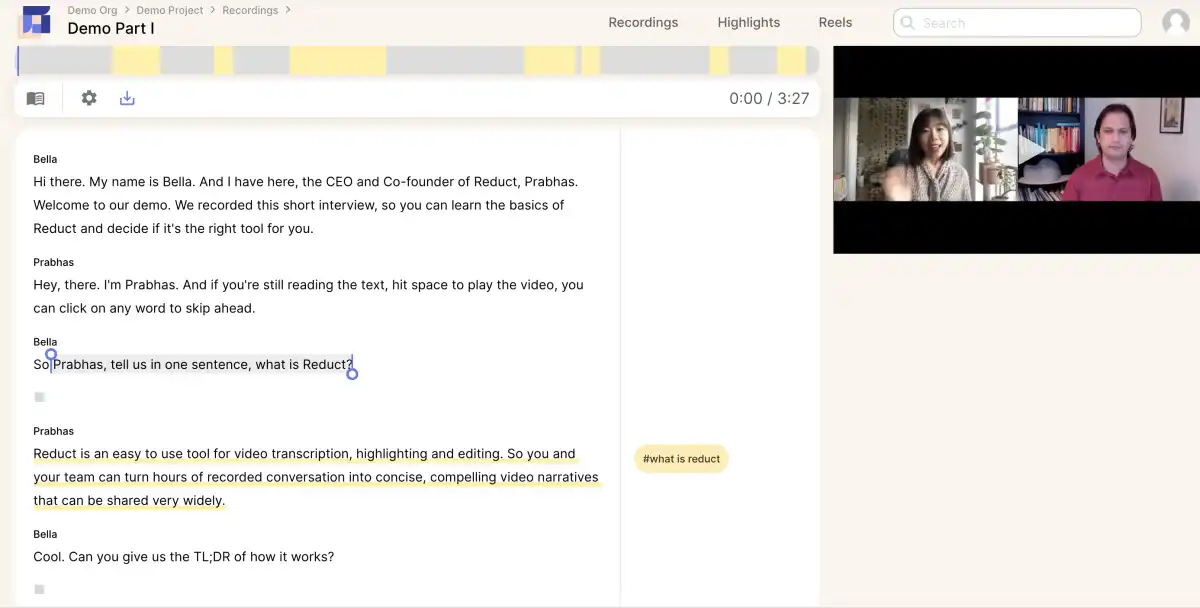
Today, Reduct.Video is an online video transcription and editing platform that allows you to edit video footage by editing the transcript. Here’s how.
Easily Find the Meaningful Moments
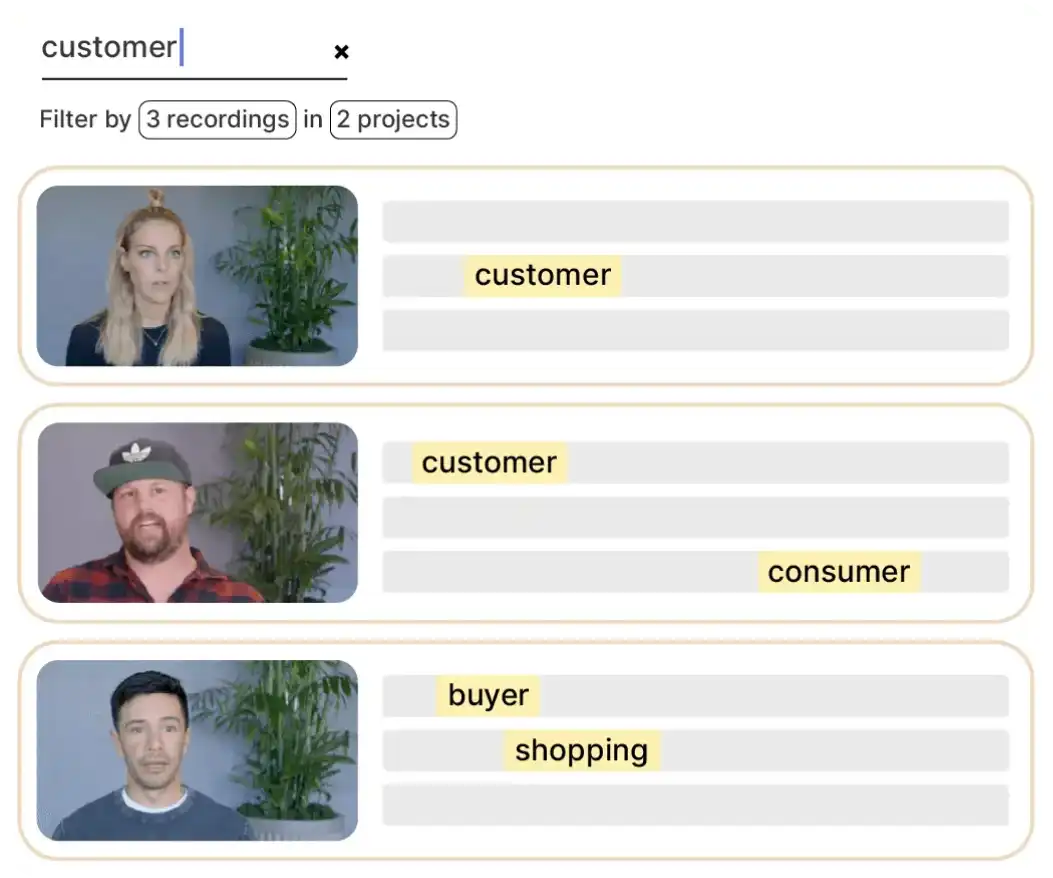
Before you even start editing, you have to find the key moments that come together to tell a powerful story.
In Reduct, you can search literally through hours of recordings (one of our customers has 500 hours of interviews they routinely sift back through), and find the exact moment someone said something important.
In fact, Reduct has a built-in fuzzy search that even searches for related words and phrases, since people often use different words to say the same thing.
Highlight to Edit and Create Clips
Here, I’m highlighting a few different segments of this video. Every time I make a highlight, Reduct automatically makes a corresponding video clip — all of the words are completely captured in my clip. No hunting for timestamps, no manual cutting and pasting. Just highlighting text:
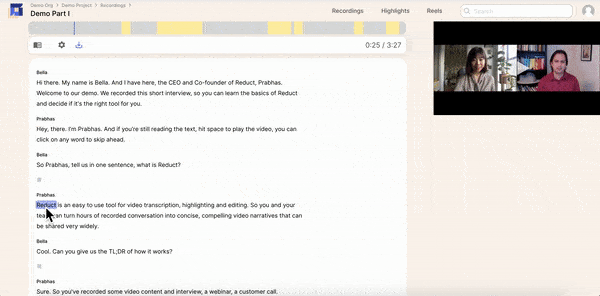
Drag and Drop Video Clips into Sequence to Build Video Narratives
After you find the right moments, you arrange what you have in a way that flows together to tell a story.
In Reduct, you can select your favorite highlights and arrange them in whatever order you’d like.
You can even drag and drop clips from different videos into one highlight reel. Our software smoothly transitions from clip-to-clip and lets you add subtitles and text slides to build context between clips.
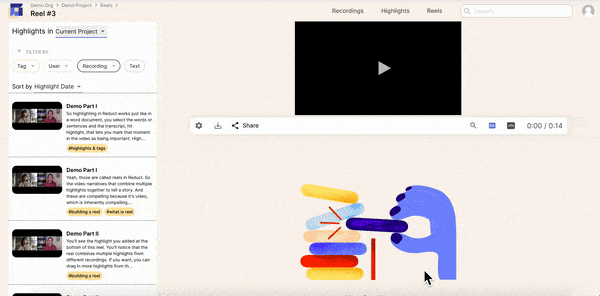
Edit Out Unnecessary Content by Striking Through Text
There are plenty of times where a clip has exactly what you want, with the perfect emotion, but the thought is littered with filler words (um, ah, like, you know). Or, sometimes your subject makes a great point, but in the middle, goes on an unrelated tangent.
With Reduct, you can just strike through text to remove those words and make a video flow perfectly:

Add Tags to Capture Themes, Insights and Patterns
Beyond editing video clips, researchers, marketers, and filmmakers also want to convey and understand patterns in conversations with multiple people.
For example, a customer research group may want to track how customers talk about Feature A vs. Feature B. Today, that is a manual process. You have to note in a document or spreadsheet all of the different times when customers talk about Feature A vs. Feature B. If you want the details, you can either reference timestamps to the original videos, or transcribe what they say.
We wanted to make that easy. So in Reduct, we allow you to add tags directly to highlighted words and phrases. You can tag “Feature A” vs. “Feature B,” as well as common sentiments or language people may be using to describe each. This allows you to easily compile key insights across many different videos.
Once you or your team have tagged your transcripts, we allow you to search, filter, and sort using those tags so you can understand key patterns and themes that cut across respondents.
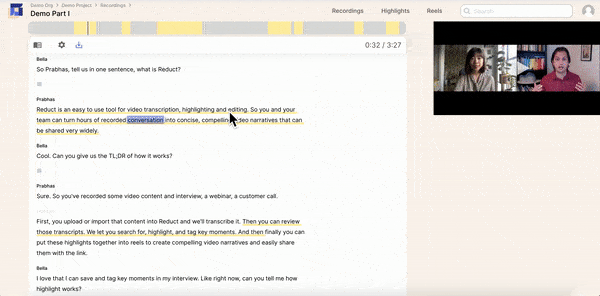
This is transformative for research teams and others doing this sort of video-based work. Your collection of highlights becomes a living breathing repository — a database of meaningful moments that you can view, slice, and collate in multiple ways.
To make this easier, we even built AI that will also suggest tags to make sure you don’t miss anything important. Between our fuzzy search, manual, and auto-suggested tagging, it’s now much easier for you to analyze trends, identify key insights, and bring them to life with video highlight reels.
Easy Collaboration to Share Impactful Insights
Collaboration was another core issue for us when we built Reduct.Video.
Video files are large, and the best way to collaborate with a co-worker who isn’t in the same location as you is often to ship them a hard drive with the video files. Reduct is completely cloud-based, and offers video storage in addition to transcription and editing. And storage is just the start — we are working on lots of different tools to help teams collaborate more efficiently on video projects.
Comment and @mention your colleague to flag an interesting moment you witness on a call. Take a great insight someone shared, make a quick highlight reel, and share it on Slack. Or suggest an alternate flow to a video your teammate is making: make a duplicate, change the order, and trim it down a bit more. It’s all possible — and simple — in Reduct.
Since the user interface is just based on text, there’s not much of a learning curve — anyone on your team can come into Reduct and search, comment on, edit, or share video files.
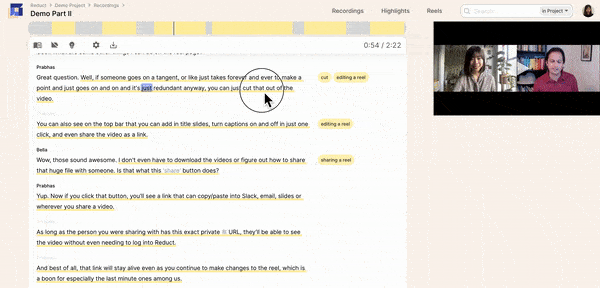
Ultra-High-Quality Transcription: Computer or Human
To make this all work, you need really high-quality transcription. When using Reduct, you can choose between computer and human transcription. Computer transcription, as the name suggests, is computer-generated, and available in minutes. Human transcription takes a little longer, but the quality is very high. We offer the fastest human transcription service available, delivering professional video transcripts back to our users within 24 hours.
If precision doesn’t matter to you, then computer transcription will get the job done quickly. But if you want a perfect transcription to present to stakeholders, or want to make sure your search always turns up accurate results, we recommend human transcription.
Who Is Using Reduct Today?
Many of our users right now are researchers and filmmakers, but there are all sorts of people who talk with stakeholders, be it in marketing, customer success, sales... If you’re getting first-hand accounts containing insights and stories worth sharing more widely, we think there's an opportunity for you to better capture and disseminate those conversations through video.
Really, anytime that you're trying to represent a stakeholder other than yourself, there's a good case to be made for letting that stakeholder speak directly.
Since we released Reduct.Video, we’ve worked with brands like Facebook, Spotify, Indeed, and Plaid, to name a few, and our platform is appealing to users of all different needs.
Our most common users include:
- User research teams
- Market research agencies
- Brand storytellers
- Content and social media marketing teams
- Documentary filmmakers
But at the end of the day, our platform is designed for anybody who has a desire to better use their video content without years of advanced video editing experience under their belt, and we love enabling people who would otherwise not edit video to share compelling stories.
The Future of Reduct.Video
Since we made the first prototype of Reduct.Video, our main goals have always been:
- Make video editing more accessible
- Make it possible to navigate hours and hours of video
- Enable teams to collaborate on and share their video projects
- We believe video is an incredibly powerful communication medium, and want to enable everyday people to use it in their everyday work.
As we continue forward, we keep those goals at the forefront of every improvement or minor tweak we make. We’re not interested in delving into crazy advanced editing features or introducing the latest whizz bang special effects to our users. Instead, we’re focused on uncomplicating video editing by improving our software’s ease of use and fine-tuning the tools that are already working for our users.
Get a Free Trial to start making the most of your video content.
